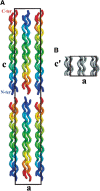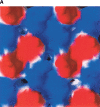Crystal structure of the collagen triple helix model [(Pro-Pro-Gly)(10)](3)
- PMID: 11790836
- PMCID: PMC2373432
- DOI: 10.1110/ps.32602
Crystal structure of the collagen triple helix model [(Pro-Pro-Gly)(10)](3)
Abstract
The first report of the full-length structure of the collagen-like polypeptide [(Pro-Pro-Gly)(10)](3) is given. This structure was obtained from crystals grown in a microgravity environment, which diffracted up to 1.3 A, using synchrotron radiation. The final model, which was refined to an R(factor) of 0.18, is the highest-resolution description of a collagen triple helix reported to date. This structure provides clues regarding a series of aspects related to collagen triple helix structure and assembly. The strict dependence of proline puckering on the position inside the Pro-Pro-Gly triplets and the correlation between backbone and side chain dihedral angles support the propensity-based mechanism of triple helix stabilization/destabilization induced by hydroxyproline. Furthermore, the analysis of [(Pro-Pro-Gly)(10)](3) packing, which is governed by electrostatic interactions, suggests that charges may act as locking features in the axial organization of triple helices in the collagen fibrils.
Figures











Similar articles
-
Repetitive interactions observed in the crystal structure of a collagen-model peptide, [(Pro-Pro-Gly)9]3.J Biochem. 2005 Aug;138(2):135-44. doi: 10.1093/jb/mvi108. J Biochem. 2005. PMID: 16091587
-
The crystal structure of the collagen-like polypeptide (glycyl-4(R)-hydroxyprolyl-4(R)-hydroxyprolyl)9 at 1.55 A resolution shows up-puckering of the proline ring in the Xaa position.J Biol Chem. 2005 May 27;280(21):20397-403. doi: 10.1074/jbc.M501453200. Epub 2005 Mar 22. J Biol Chem. 2005. PMID: 15784619
-
The triple helical structure and stability of collagen model peptide with 4(S)-hydroxyprolyl-Pro-Gly units.Biopolymers. 2012;98(2):111-21. doi: 10.1002/bip.21730. Epub 2011 Oct 24. Biopolymers. 2012. PMID: 22020801
-
Collagen structure: the Madras triple helix and the current scenario.IUBMB Life. 2005 Mar;57(3):161-72. doi: 10.1080/15216540500090710. IUBMB Life. 2005. PMID: 16036578 Review.
-
Triple-helical peptides: an approach to collagen conformation, stability, and self-association.Biopolymers. 2008 May;89(5):345-53. doi: 10.1002/bip.20958. Biopolymers. 2008. PMID: 18275087 Review.
Cited by
-
Bacterial collagen-binding domain targets undertwisted regions of collagen.Protein Sci. 2012 Oct;21(10):1554-65. doi: 10.1002/pro.2145. Protein Sci. 2012. PMID: 22898990 Free PMC article.
-
A solution structure analysis reveals a bent collagen triple helix in the complement activation recognition molecule mannan-binding lectin.J Biol Chem. 2023 Feb;299(2):102799. doi: 10.1016/j.jbc.2022.102799. Epub 2022 Dec 15. J Biol Chem. 2023. PMID: 36528062 Free PMC article.
-
Theoretical study of the NLO responses of some natural and unnatural amino acids used as probe molecules.J Mol Model. 2014 Aug;20(8):2388. doi: 10.1007/s00894-014-2388-0. Epub 2014 Aug 5. J Mol Model. 2014. PMID: 25092242
-
Decoding elegant interplay among different stereo-electronic effects due to the ancient prolyl-4-hydroxylation stabilizing collagenous helicity.iScience. 2025 Apr 10;28(5):112393. doi: 10.1016/j.isci.2025.112393. eCollection 2025 May 16. iScience. 2025. PMID: 40343281 Free PMC article.
-
A structural role for tryptophan in proteins, and the ubiquitous Trp Cδ1-H...O=C (backbone) hydrogen bond.Acta Crystallogr D Struct Biol. 2024 Jul 1;80(Pt 7):551-562. doi: 10.1107/S2059798324005515. Epub 2024 Jun 28. Acta Crystallogr D Struct Biol. 2024. PMID: 38941144 Free PMC article.
References
-
- Bella, J., Brodsky, B., and Berman, H.M. 1995. Hydration structure of a collagen peptide. Structure 3 893–906. - PubMed
-
- Bella, J., Eaton, M., Brodsky, B., and Berman, H.M. 1994. Crystal and molecular structure of a collagen-like peptide at 1.9 A resolution. Science 266 75–81. - PubMed
-
- Berisio, R., Vitagliano, L., Mazzarella, L., and Zagari, A. 2001. Crystal structure determination of the collagen-like polypeptide with repeating sequence Pro-Hyp-Gly: Implications for hydration. Biopolymers 56 8–13. - PubMed
-
- Berisio, R., Vitagliano, L., Sorrentino, G., Carotenuto, L., Piccolo, C., Mazzarella, L., and Zagari, A. 2000. Effects of microgravity on the crystal quality of a collagen-like polypeptide. Acta Crystallogr. D 56 55–61. - PubMed
-
- Berman, H.M., Bhat, T.N., Bourne, P.E., Feng, Z., Gilliland, G., Weissig, H., and Westbrook, J. 2000. The Protein Data Bank and the challenge of structural genomics. Nat. Struct. Biol. 7 957–959. - PubMed
Publication types
MeSH terms
Substances
Associated data
- Actions
LinkOut - more resources
Full Text Sources
Other Literature Sources
Molecular Biology Databases

